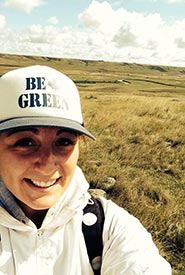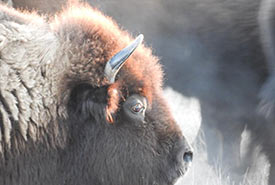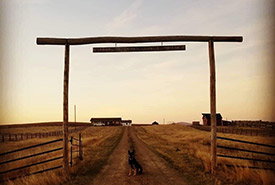Five years with NCC (part one)

Kylie doing baseline work at Stark Coulee, SK (Photo by NCC)
I am Kylie (Garchinski) McGregor, natural area manager for the Missouri Coteau Natural Area with the Nature Conservancy of Canada (NCC). I started here as an intern in 2014 and have worked on and off for the organization since. Throughout my NCC career, I have spent countless hours at the Old Man on His Back Prairie and Heritage Conservation Area (OMB), a place I have grown to love and think of as my second home.
It is hard not to fall in love with OMB. When you are there, it feels as if you have stepped back in time. OMB was designated as a Nocturnal Sky Preserve by the Royal Astronomical Society of Canada in 2015, so it is a great place to see the stars, and it has the most beautiful sunsets. Beyond the peaceful and scenic landscapes, there are other aspects of OMB that have made their way into my heart: the animals that reside there, and the people I’ve met on the property.
Year-round, OMB is home to a herd of plains bison and, during the summer, about 200 head of cattle from neighbouring ranches. These neighbours are true stewards of the land, in the ways that they respect the land and how they manage it. My journey with NCC has been somewhat of a winding road, and I thought I would touch on some of the highlights.
OMB: My second home

Plains bison (Photo by Kim Bennett)
As an intern, Natalie Hassett, the manager at OMB, took me under her wing. When we weren’t checking fences, fixing water bowls or doing property monitoring in the area, she introduced me to the neighbours and patrons (neighbours that graze cattle under the responsibility of our pasture rider) of OMB. In 2016, when it came time for me to fill Natalie’s (metaphorically HUGE) shoes while she went on maternity leave, I started to really get to know these neighbours and patrons.
My first year attending the OMB bison round-up, I was dubbed “the boss.” Having had experience processing cattle, I was not totally new to this game, but working with bison for the first time was definitely an eye opener. I felt responsible for the well-being of the animals, NCC staff and the patrons.
Everyone was patient with me, and we made it through my first round-up without incident. As the sun set on another day at the ranch, all my stress disappeared as the herd was released back into the winter pasture. These wild beasts had stolen a little piece of my heart; I hoped they would have an easy winter.
Earning cowgirl cred
I think I finally earned some cowgirl credit with the patrons the following summer, when I restrained a calf that needed to be treated with medication before being turned out to pasture. Now, this was not as majestic as the typical cowboy experience you might read about in a romance novel. For quite some time, it was looking like the calf would win as it dragged me through the...we will just call it...mud. But finally I gained control so he could be given his medication.

OMB yardsite, 2018 (Photo by NCC)
After that event, patrons started stopping by the interpretive centre for coffee when they saw my truck there, bringing an extra horse for me to tag along on while checking cattle, and eventually, inviting me for supper at their houses and to community events in town.
When it came time for my second round-up, there was a new project on the go. We had partnered with the University of Saskatchewan to fit patron cattle and NCC’s bison cows with GPS collars to track their grazing patterns and reactions to different variables within their grazing pastures. This was an added activity to the already full-day bison round-up. Despite a rogue bull jumping some fences and a few other events, we made it through.
As the 2017 bison round up came to a close, so did my duties as the southwest Saskatchewan natural area manager. Natalie returned to work in the new year, and I moved into a new role with NCC. Read about the highlights in part two of my blog.


